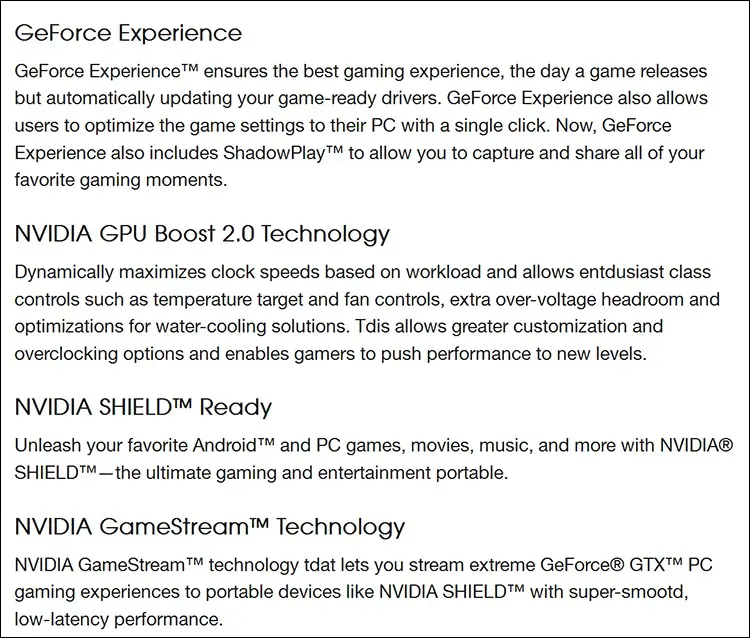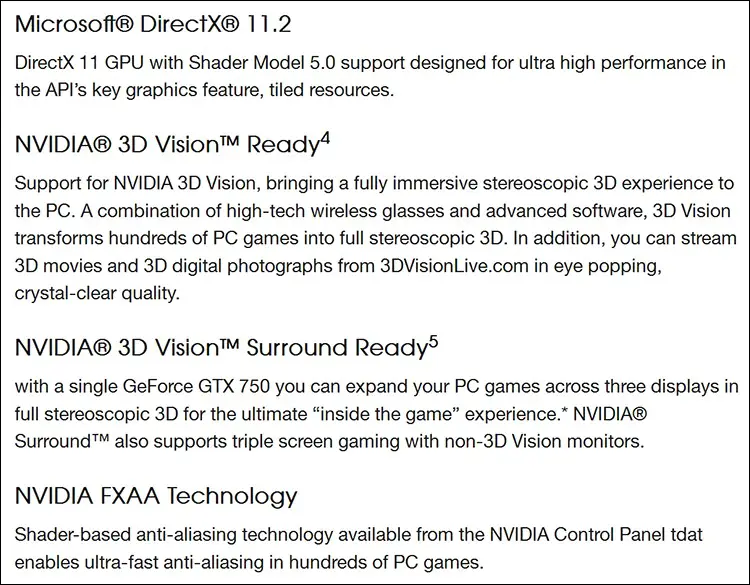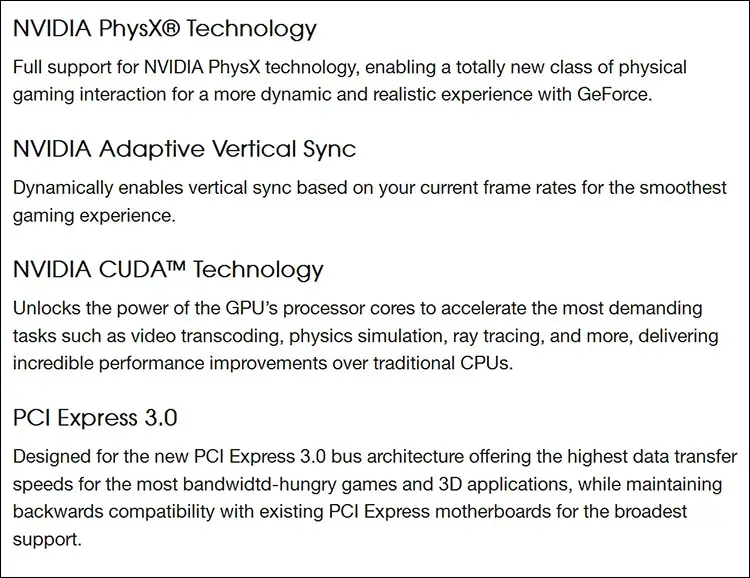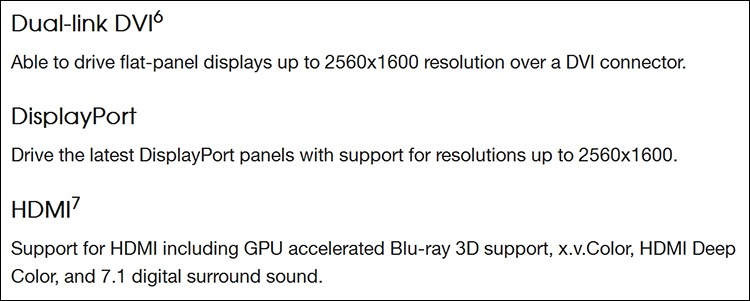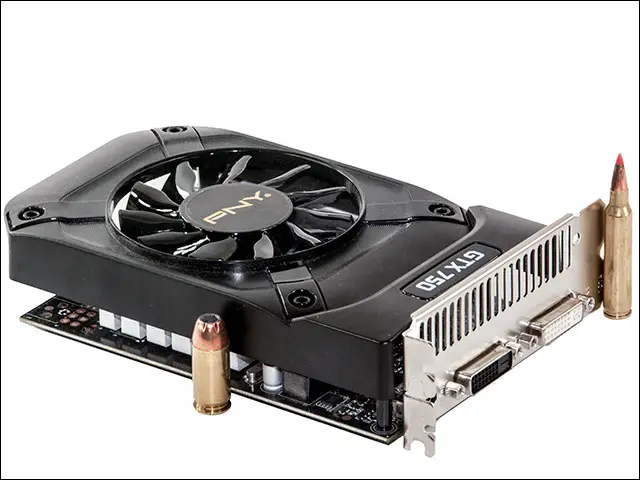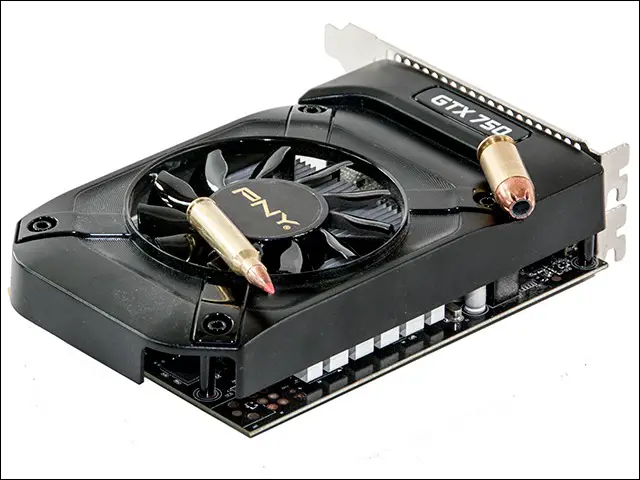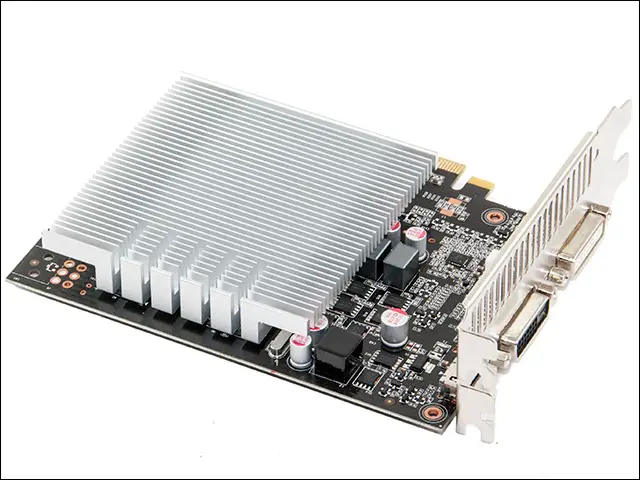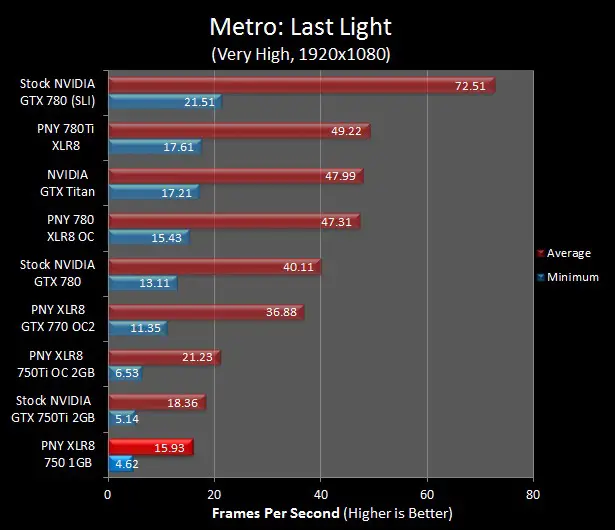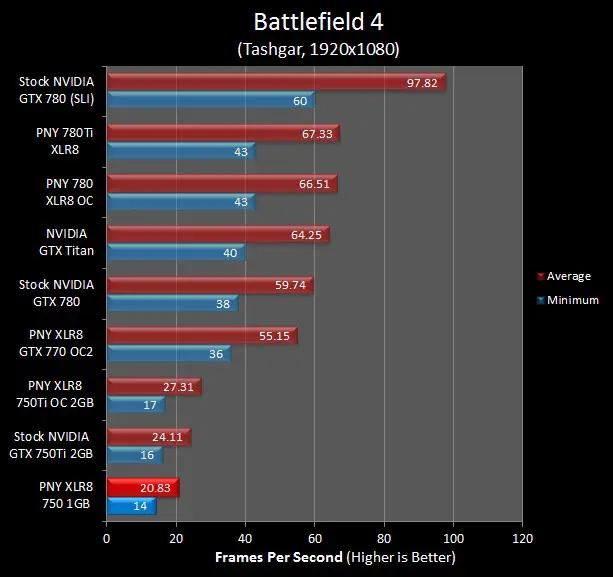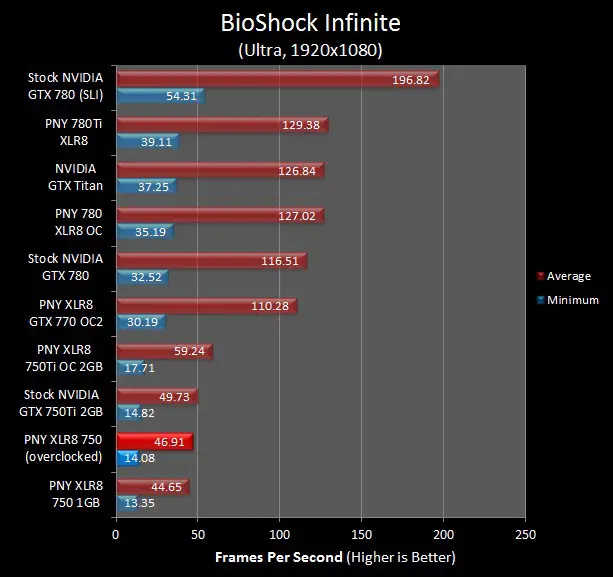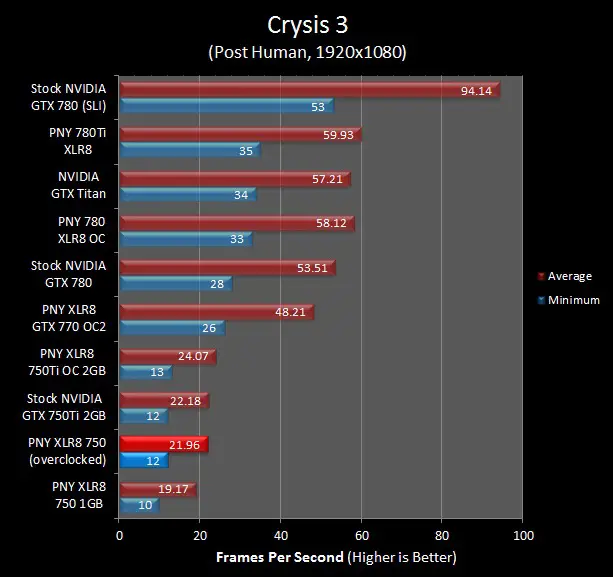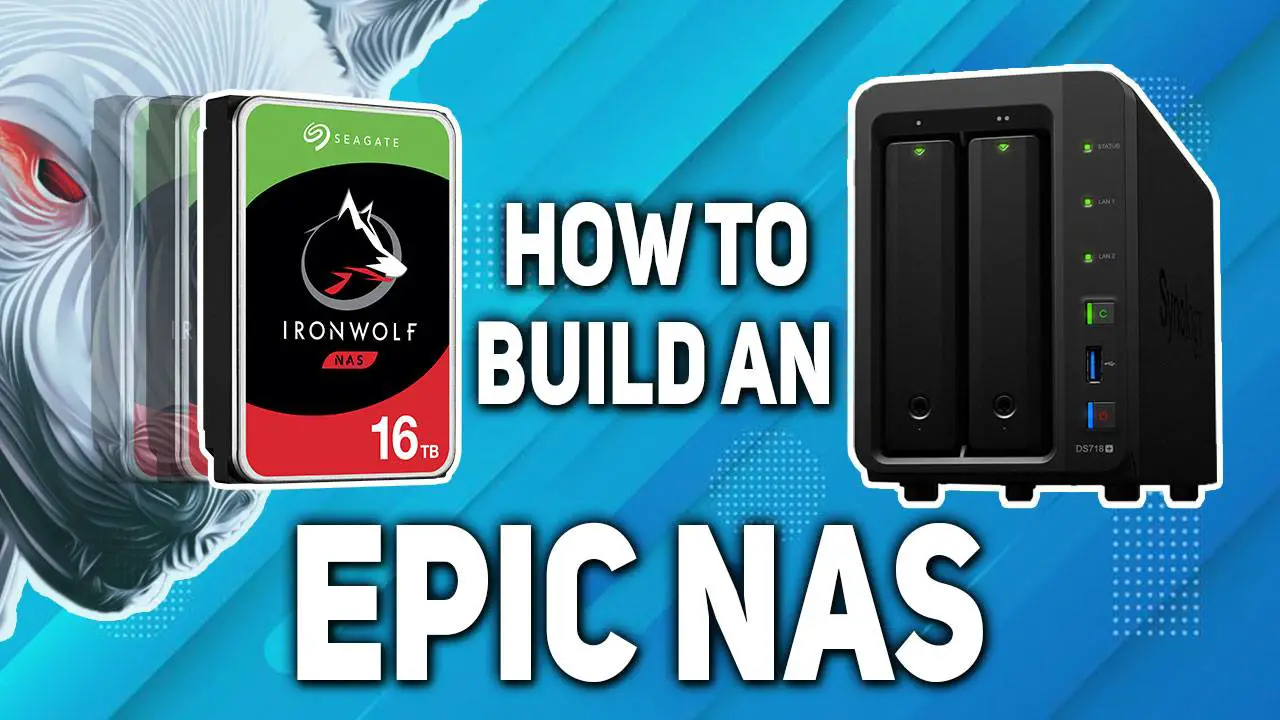PNY GTX750 – Intro
Introduction
Not that long ago we took a long hard look at the PNY 750Ti OC2 and walked away pleasantly surprised by the amount of value that particular model offered. Everything from the ultra-low noise profile, to its low power consumption, to its only minor increase in price left us impressed and made us rethink the entire 750 series. After all if their most expensive ‘flagship’ 750Ti model could impress us with its value, what tricks did PNY’s other cheaper 750’s have up their sleeves? For this reason we have once again gone back to the 750 series and are going to take another in-depth look at it; this time however we are going to look at the other end of the 750 spectrum and take a long hard look at PNY’s entry level, non-Ti, non-overclocked NVidia GeForce 750. Specifically we are going to put their 750 XLR8 1GB under the microscope and see if any of the magic that infuses their 750Ti OC has trickled down to the even more inexpensive models.

As with any 750 series video card, our largest concern about this model has to do with performance. After all, as a base model 750 the PNY 750 XLR8 only has 512 Cuda cores, makes use of a paltry 1GB of memory running at 5,000MHz on a rather narrow 128-bit memory bus. More importantly still, this particular PNY 750 has no factor overclocking applied to it. This means its base clock of 1020 and boost clock of 1085 is completely ‘reference’ levels. This is a combination that has proven to be mediocre at best, and is worrisome – as a lot of the 750Ti OC2’s ‘magic’ came from a mega dose of testosterone in the form of a huge factory overclock.
With that being said, while we fully expect the performance to be in line with what other ‘stock’ NVIDIA GeForce 750’s can offer, sheer performance is only one small part of the equation. For numerous scenarios, noise performance is just as important as sheer pixel pushing speed. Thankfully, PNY has not opted to carry over the reference design heatsink and fan that NVIDIA recommend. Instead they have opted for a fully custom dual slot design that also graces the 750Ti OC 2GB we recently reviewed. Based on previous experience with this custom cooler this single fan based cooling unit should have no problems dissipating the 55 watts the Maxwell ‘750’ core can produce. We say thankfully as NVIDIA may do many things very well but designing low noise, low cost, high performance cooling solutions is not one of them. To be blunt, stock 750 coolers stink. They are loud, obnoxious things that belie the low TDP nature of the next generation Maxwell core. In fact, if it wasn’t for this custom heatsink we would have flushed this review before continuing and considered it an idea that should never see the light of day. Needless to say we do have high hopes for this little GPU cooler that PNY has opted for. We are not exaggerating when we say that it has the potential to make or break the 750 and will play a large role in our final evaluation.
The reason this single fan cooler is so important is because this is a stock 750 video card. As PNY has shown in the past, the Maxwell core usually has a lot of headroom and if this custom cooler can keep temperatures in check, this card has the potential for greatness, or at least great value. In fact with an asking price so low as to be bordering on absurd for a ‘serious’ video card if the overclocking headroom is there, this little brother of the 750Ti OC2 may just possibly surpass that card in the crucial value department. That however is a lot of ‘ifs’, ‘maybes’ and ‘possibly’, but it is a still a lot of potential that needs to be investigated.
PNY GTX750 – Specs and Features
Specifications and Features
PNY GTX750 – Closer Look
A Closer Look at the PNY GeForce GTX 750 XLR8 1GB
Either PNY loves this shipping container or their production division really wanted to simplify the logistics of shipping out (nearly) all NVIDIA 7 series card in the same container. We say this because this is the exact same box everything from a PNY Titan on down gets and it is only the rare specialty model like the PNY 770 OC2 ((XXX insert a URL LINK TO IT) that get a different shipping container. This does make it a tad confusing as you may very well see multiple PNY video cards next to each other in a store and the only way to tell them apart would be to – gasp – read the box! For the 8 second video generation that is indeed asking a lot.
On the positive side this large shipping container does offer a level of protection rarely seen with sub $150 cards. This commitment to ensuring your video card arrives safe and sound is further underscored by the large internal plastic container that PNY has opted for. Much like the box it was designed around much, much large and expensive models and unless your PNY 750’s shipping container gets cut in half there is a better than even chance of it arriving safe and sound. Put another way, if your friendly neighborhood delivery man loves to flick or kick your parcels to your door this is large box is a positive to take into consideration!
Upon first looking at this stock 750 we thought we were seeing double as this single fan, heatsink is for all intents and purposes the exact same as what the 750Ti OC 2GB (xx insert link – make the words hotlinkable) we recently revised uses. This is certainly a good thing as many manufactures cut corners on their ‘stock’ budget video cards and while the 750 series is more a cross over model between the really anemic 720,730 and 740s and the more performance orientated 760 series, they still usually are hobbled by downright bad stock coolers.
We can literally count on one hand the number of non-overclocked ‘reference’ 750 models which are given the royal treatment – and now we can add one more to the list as PNY obviously don’t like to cut corners. Considering this cooler also comes with a lifetime warranty and many older video cards die from ‘heat stroke’ the extra cooling potential of this custom heatsink probably will pay dividends for PNY in the long run. More importantly thanks to its large aluminum heatsink and single 82mm Apistek fan this custom design has proven to be more than enough to keep a heavily overclock 750Ti’s temperatures in check. Considering the standard non-Ti 750 is even cooler running we have very little doubts it will do an even better job with this 55TDP Maxwell core.
Unfortunately, it will indeed have to be able to be cool the GPU better than most 750’s as it costs $10 more than the typical 750 and is within ten dollars of a stock 750Ti video card. That may not sound like much of a big deal, but for only twenty dollars more than this cards MSRP of $130 you can get a factory overclocked 750Ti OC 2GB… well that is twenty dollars that may just be worth spending. Even if twenty dollars is too much for your budget, most budgets can stretch by ten dollars and for ten dollars more the 750Ti does have much more impressive specs. This is because the standard 750 has been extremely hobbled by NVIDIA and it is almost as if they just want it to be a demonstrator model of how power efficient and cool running their next generation Maxwell core really was – rather than be a serious video card design.
To be precise a stock 750Ti is a 28nm GM107 core with 640 CUDA cores, 16 ROPs and 40 Texture units enabled running at 1020/1085Mhz. This combination has proven to be barely adequate but is much more powerful than its smaller brother the 750. A stock 750 also uses the GM107 core but has even more meat cut from it (only 512 CUDA cores and 32 Texture Units) and yet also runs at 1020/1085. As you can see, this is why the more expensive PNY XLR8 750 needs to be able to overclock like a bat of hell in order to compete. PNY really should have forgone a stock 750 and instead only offered factory overclocked 750s. This would have made the ten dollar investment a lot easier to justify – as it’s only an extra ten dollars.
While we fully and readily admit to being impressed by the custom heatsink PNY has opted for, there are a few issues with this design. First and foremost is that while it indeed does do a bang up job at cooling it does needlessly add length to what should be an extremely compact model. We are unsure whether PNY’s engineers are pathologically incapable of offering standard ‘reference’ length for NVIDIA cards, or whether it simply is the fact that this cooler was first designed with the 750Ti in mind, then carried over to the 750 before the engineers realized it was bigger than it needed to be. In either case, by simply flipping it over you can see that the plastic top fascia hangs over then PCB by a good inch or more. As we have said in the past this makes the card longer than it needs to be and does so without adding any benefits. On the positive side, this custom video card is still fairly small and yet because it uses such a robust – for its class – heatsink the performance should be stellar in both the noise and temperature departments.
Even without removing said heatsink we can see that PNY has opted for what is basically the same 2+1 power delivery system that they use for their 750Ti OC. While we wish it was even more robust, this is still more than enough for a stock 750 video card. This is doubly true when you consider that it does not have any additional power input ports and instead is limited to what the PCIe bus can provide. On the plus side, and unlike true NVIDIA reference designs, the VRM and RAM components are also cooled by the down-draft fan.
Turning the card around we can see that while this card may be a two slot design instead of one slot like a reference 750, it nevertheless keeps to NIVIDIA’s reference output selection. As with the 750Ti the bottom row basically consists of the usual min-HDMI port and two DVI ports, while the top row is dedicated solely to cooling slots. This is actually a missed opportunity as PNY could have easily included a full sized HDMI port, and even a DisplayPort. As it stands the output selection is decent, if not exactly above average.
Overall for a ‘stock’ NVIDIA GTX 750 the PNY 750 XLR8 1GB is moderately impressive in what is usually a mildly disappointing corner of NVIDIA’s current lineup. Hopefully in the case of the XLR8 750, beauty is more than skin deep and this little card has some tricks up its sleeve in the performance department. After all a kick ass heatsink should allow the card to keep from throttling performance – even more than NVIDIA has done at the hardware level – and this should allow this 750 to be one of the best examples of what a stock 750 can do.
SAME COOLER AS THE 750Tis
PNY GTX750 – Testing Methodology
Testing Methodology
To fully test the abilities of a given video card, we have used a blend of in-game benchmarks and custom recorded real world game benchmarking. For custom game play we have used FRAPS to record the minimum and average frame rates and do so for a set period of time. All tests were run a minimum of four times and the scores are the average of all four runs.
All games were patched to their latest version. The OS was a fresh clean install of Windows 7 with all latest hotfixes, patches and updates applied. All games were tested at the two of the most popular resolutions of 1080P (1920×1080) and then again at 1440P (2560×1440). This means each game tested was run a minimum of 8 times: 4 @ 1080P and 4 @1440P. Before testing Unigine’s Valley benchmark was run for 15 minutes to ‘warm up’ the video card. This was done to ensure that long term performance and not short term performance is being illustrated.
The games used for testing were:
Sleeping Dogs
Metro: Last Light
BioShock Infinite
Crysis 3
Batman: Arkham Origins
Tomb Raider
Battlefield 4
Assassins Creed: Black Flag
Call of Duty: Ghosts
For stress testing we used Unigine’s Valley benchmark.
For overclocking we used either the manufactures included software overclocking program or if necessary EVGA’s Precision X program.
Drivers:
GeForce 337.88
Main Test System
Processor: Intel i7 4770K
Memory: 16GB GSkill 2666 Trident X CL11 1.6v
Motherboard: MSI MPower Max Z87
Cooling: Corsair H100i
SSD: 1x Seagate 600 Pro 400GB, 2x Intel DC S3700 800GB SSDs.
Power Supply: Corsair AX860i
Monitor: Dell U2714H
OS: Windows 7 Ultimate x64 SP1
PNY GTX750 – Synthetic Testing Explained
Synthetic Game Benchmarks
In the Synthetic Gaming Benchmarks section we will show a number of benchmark comparisons of PNY GeForce GTX 770 XLR8 OC2 and other comparable GPUs, using various benchmarks which come included with five popular modern PC games. This will illustrate how much performance this card has to offer. To ensure that long term performance is and not short term performance is illustrated 15 minutes of Unigine’s Valley benchmark was run to ‘warm up’ the video card. Only then were any tests run on the now warm video card.
Please Note: We have not included 1440P results for the 750 series as these cards are simply not optimal for such resolutions. These are designed for 1080P and as such are being only compared at this resolution. Doing otherwise would be doing you our readers a great disservice.
PNY GTX750 – Sleeping Dogs
Sleeping Dogs Gaming Benchmark
Sleeping Dogs is an open world action-adventure video game developed by United Front Games in conjunction with Square Enix London Studios and published by Square Enix, released on August 2012. Sleeping Dogs has a benchmark component to it that mimics game play and an average of four runs was taken.
The settings used in the testing below are the Extreme display settings and a resolution of 1920×1080. World density is set to extreme, Vsync disabled, high-res textures are enabled, and shadow resolution, shadow filtering, screen space ambient occlusion, and quality motion blur are all set to high.
We were afraid this would happen and it appears that even that excellent custom heatsink – which allows the heat levels to stay below the boost cut-off levels – is not enough to make the PNY XLR8 1GB rise above its class. Put simply, if you like to play modern games at even 1080P resolutions you are going to be turning a lot of the ‘eye candy’ processing options off. Doing otherwise simply puts too much strain on this 750 core. PNY obviously made a miscalculation in leaving this card at stock speeds. If they had applied a stock overclock the extra ten dollars a stock 750Ti commands may not have seemed as good a deal as it does right now. As it stands if you are the kind of person who self-identify as a “NVIDIA Fanboi” you may want to take your medication now and go to your happy place….as we have a feeling the rest of these results are going to just as grim.
PNY GTX750 – Metro: Last Light
Metro: Last Light Gaming Benchmark
Metro: Last Light is a DX11 first-person shooter video game developed by Ukrainian studio 4A Games and published by Deep Silver released in May 2013. The game is set in a post-apocalyptic world and features action-oriented gameplay. The game has a benchmark component to it that mimics game play. Scene D6 was used and an average of four runs was taken.
The settings used in the testing below are Very High for quality and a resolution of 1920×1080. DirectX 11 is used, texture filtering is set to AF 16X, motion blur is normal, SSA turned on and tessellation is set to high.
Results like these bring to mind phrases like ‘looking at the south end of a north bound mule’ as they are all bad. These results are every bit as bad as we feared they would be and even with a custom cooler that allows the core’s boost settings to basically be the ‘real’ performance levels they are not enough to save this card from mediocrity. Obviously we strongly recommend spending the couple extra dollars and getting a 750Ti OC as it is a much superior card.
PNY GTX750 – BioShock Infinite
BioShock Infinite Gaming Benchmark
BioShock Infinite is a first-person shooter video game developed by Irrational Games, and published by 2K Games released in March 2013. The game has a benchmark component to it that mimics game play and an average of four runs was taken.
The settings used in the testing below are UltraDX11 (option 3) for quality and a resolution of 1920×1080.
These results just underscore how badly NVIDIA has hobbled their stock 750 series. This card needs more megahertz and without them this card is simply hammered in comparison to what even a stock 750Ti can do. Considering a 750Ti performance levels are barely tolerable that does place this PNY 750 XLR8 1GB on the wrong side of the ‘worth it’ cut-off point every PC builder has.
PNY GTX750 – Tomb Raider
Tomb Raider Gaming Benchmark
Tomb Raider is an action-adventure video game published by Square Enix and released in March 2013. The game has a benchmark component to it that mimics game play and an average of four runs was taken.
The settings used in the testing below are Ultimate default settings for quality, VSync disabled and a resolution of 1920×1080.
Surprisingly enough, it appears as if this non-NVIDIA friendly game actually likes the 750 more than the 750Ti. That is to say its performance still is anemic but in comparison to most NV cards, it’s not outright terrible either. Of course, these frames rates are more ‘slideshow’ than ‘smooth’ but it is nice to see this card come close to justifying its asking price every once in a while. Though the operative word here is ‘close’ and even here in Womb….err Tomb Raider a stock 750Ti is a much better value than this tricked out 750 XLR8.
PNY GTX750 – Batman Arkham Origins
Batman Arkham Origins Gaming Benchmark
Batman: AO is an action-adventure video game published by Warner Bros and released in October 2013. The game has a benchmark component to it that mimics game play and an average of four runs was taken.
The settings used in the testing below are highest settings for quality, VSync disabled and a resolution of 1920×1080. Anti-Aliasing is set to TXAA (high). Motion blur, Distortion, Lens Flare, Light Shafts, and Reflections set to On. Geometry, Dynamic Shadows, Depth of Field, and Ambient Occlusion all set to DX11 Enhanced.
Every once in a while this card will surprise you, but this is more a case of beating lowered expectations than actual impressive performance. NIVIDA really should have pushed the speed envelope with their reference settings, as it stands a stock 750 is a rather mediocre performer – and that is a damn shame as the PNY 750 XLR8 1GB is one of the best examples of its class. Too bad it’s ‘class’ takes the short bus to school.
PNY GTX750 – Real World Benchmarks Explained
Real World In-Game Benchmarks
In the Real Gaming Benchmarks section we will show a number of timed real world game play results using FRAPS and four popular modern PC games. This will illustrate how much performance the PNY GeForce GTX 770 XLR8 OC2 has to offer and do so in a way which cannot be unduly skewed by driver ‘optimizations’ which have been included for the sole purpose of improving benchmark results. While not as common as it once was such optimizing is still not unheard of by either AMD or NVIDIA. Once again Unigine’s Valley benchmark was run for 15 minutes to ‘warm up’ the video card prior to testing.
PNY GTX750 – Battlefield 4
Battlefield 4 Gaming Benchmark
Battlefield 4 is first person shooter video game, published by EA Digital Illusions CE and released in October 2013. Unlike most, this games does not include an in-game benchmark. This makes it perfect for more real world gaming tests. To obtain repeatable results we have used FRAPs and recorded the first 90 seconds of the single player Tashgar level. An average of four runs was taken.
The settings used in the testing below are Ultra pre-set for quality, with VSync disabled and a resolution of 1920×1080.
These numbers just underscore exactly how demanding modern games really are. After all, not that many years ago five hundred and twelve CUDA cores was the stuff of PC gaming enthusiasts wet dreams. Now, it’s a big case of ‘meh’. Obviously, PNY has done what they can but when you combine a purposely hobbled core with an anemic 128-bit bus the results speak for themselves.
PNY GTX750 – Assassins Creed: Black Flag
Assassins Creed: Black Flag Gaming Benchmark
Assassins Creed: BF is an historical action-adventure video game, published by published by Ubisoft and released in October 2013. Like Battlefield 4 this games does not include an in-game benchmark. This makes it perfect for more real world gaming testing. To obtain repeatable results we have used FRAPs and recorded a custom run through Havana’s marketplace. An average of four runs was taken.
The settings used in the testing below are highest settings for quality, VSync disabled and a resolution of 1920×1080. Environment quality was set to very high, Anti-Aliasing was set to TXAA 4X, Ambient Occlusion set to HBAO+ (high), Shadow Quality set to ‘soft shadow’, Motion Blur and Volumetric Blur both set to On. Texture Quality, Reflection Quality, and God Rays all set to High.
With almost sickening monotony we can see that this rather special 750 gets its butt handed to it by even ‘stock’ 750Ti’s. Considering a stock 750Ti will only set consumers back about ten dollars more that is ten dollars you do not want to cut from your budget. What a bloody shame.
PNY GTX750 – Call of Duty: Ghosts
Call of Duty: Ghosts Gaming Benchmark
Call of Duty: Ghosts is a first person shooter video game, published by Activision and released in October 2013. Since it does not include an in-game benchmark, it perfect for more real world gaming testing. To obtain repeatable results we have used FRAPs and recorded 90 seconds of the single player ‘Ghost Stories’ level, starting as soon as we resume control of Logan back on Earth. An average of four runs was taken.
The settings used in the testing below are highest settings for quality, VSync disabled and a resolution of 1920×1080. Image Quality, Textures Resolution, Normal Map Resolution, and Specular Map Resolution set to Extra. Screen Space Ambient Occlusion and Antistrophic Filtering set to High, Terrain Detail set to ON, and Anti-Aliasing was set to TXAA 4X. With Shadows, Distortion, Motion Blue and Depth of Field set to Yes.
Once again a stock 750 is an anemic performer. No matter what PNY could do on the noise side of the equation at the end of the day this card is still a NVIDIA 750 running at stock speeds – and that is a rather less than optimal combination.
PNY GTX750 – Crysis 3
Crysis 3 Gaming Benchmark
Crysis 3 is a first person shooter video game, published by Electronic Arts and released in February 2013. While older than some of the others it is one of the most visually stunning games released to date and puts a lot of demands on the GPU. This makes it perfect for more real world gaming testing. To obtain repeatable results we have used FRAPs and recorded 90 seconds of the single player ‘Post Human’ level, starting as soon as soon as prophet is handed a Hammer II pistol by Psycho. An average of four runs was taken.
The settings used in the testing below are highest settings for quality, VSync disabled and a resolution of 1920×1080. Texture Quality, Game Effects, Objects, Particles, Post Processing, Shadows, Shading, Water, and System Specs all set to Very High. Motion Blur was set to High and Lens Flare was set to On. Anti-Aliasing was set to MSAA 8X and Antistrophic Filtering was set to 16x.
And once again we can see just how much of a disservice NVIDIA has done to consumers by releasing the 750 upon unsuspecting consumers. No matter how much PNY has done to put some kickass lipstick on this pig, at the end of the day all stock 750s are pigs. PNY really should have skipped releasing a stock 750, cut to the chase and overclocked the hell out of their 750 offering. That is the only way any 750 would have a hope in hell of justifying its asking price.
PNY GTX750 – Temperature Analysis
Video Card Temperature Results
For all temperature testing the cards were used in an open test bed environment. Ambient temperature was kept at a constant 20°C (+/- 0.5°C) and if the ambient room temperatures rose above 21°C or dropped below 19°C at any time, all benchmarking was stopped until proper temperatures could normalized.
For Idle tests, we let the system idle at the Windows 7 desktop for 25 minutes and recorded the peak temperature.
For Load tests, we ran Unigine’s Valley benchmark for 20 minutes.
To be perfectly candid this custom heatsink is almost overkill for this itty bitty 750. This heatsink is meant to keep highly overclocked 750Ti’s temperatures in check so of course it’s going to keep this lower power stock 750 cool. By the same token there really is no such thing as ‘overkill’ – only ‘open fire’ and ‘I need to reload’. In other words having too much of a good thing is never a bad thing, and boy is this custom heatsink qualify as a Good Thing(TM)!
PNY GTX750 – Sound Level Test
Sound Level Test Results
While everyone “hears” noise differently there is one easy way to remove all subjectiveness and easily compare different fans: use a sound level meter. This way you can easily compare the various fans noise envelopes without us coloring the results and see what fans fit within your personal comfort level. Of course, we will endeavor to try and explain the various results – which are taken at a 15 inch distance from the GPU’s fan(s) – to help you gain an even better understanding of how loud a cooler’s stock fan is, but even if you discount our personal opinions, the fact remains numbers don’t lie.
For Idle tests, we let the system idle at the Windows 7 desktop for 25 minutes and recorded the peak dB.
For Load tests, we ran Unigine’s Valley benchmark for 20 minutes and recorded the peak dB.
We are not surprised in the least by these excellent results as this custom heatsink has already proven its mettle with hotter running cards like the 750Ti OC. When you take a downright silent custom heatsink and only use it to cool lower heat producing cards the end results are going to be nothing less than spectacular. Water is wet, sky is blue, and in the PNY 750 XLR8’s case this means a card that is so quiet as to be well below the average systems noise ‘floor’ and thus unnoticeable.
PNY GTX750 – Power Consumption
System Power Consumption
To obtain accurate results we have connected the system to a Power Angle power meter that has in turn been attached to a 1500watt UPS. This ensures only 120volt power is supplied to the PSU and removes an variances that could potential crop up because of brownouts and power spikes.
In order to stress the video card we have once again used Unigine’s Valley benchmark and ran it for 20 minutes to determine peak system power consumption. For idle results we have let the system idle at the Windows 7 desktop for 25 minutes and recorded the peak idle power consumption.
Downright anemic power consumption is, and always will be, the crown jewel of the cut-down GM107 core. It is just too bad NVIDIA had to cut away so much muscle to get numbers these low. Once again, this cards numbers are indeed impressive, but there does come a point of diminishing returns. Yes this card sips power like no ones’ business but then again the 750Ti is not too shabby either! Put simply, we don’t see many outside of Small Form Factor HTPC builders – who will most likely use this video card for MadVR up conversion duties – who will care about the few watts power savings over that of a 750Ti. Both are power misers, just one uses a few extra watts in order to give actually good performance.
PNY GTX750 – Overclocking
Overclocking
To discover our PNY GeForce GTX 750 XLR8 sample’s overclocking abilities we used EVGA’s Precision X software and began raising power and thermal thresholds to the maximum allowed and then increased the voltage also to the maximum permitted. Then using Unigine’s Valley benchmark we began stability testing.
Where this card does come with an extremely potent cooler but has only reference clock speeds we were expecting to see huge gains in the overclocking section. In this regards we were not disappointed. With only moderate effort we were able to reach a peak of 1,382MHz on this cool running Maxwell core. This is an additional two hundred and ninety seven megahertz over the stock boost setting of 1085MHZ, which translates to an additional 27.2% of free performance. This is the highest overclock we have been able to achieve on any video card, though this is only 2Mhz faster than what we could get on the 750Ti.
On the memory side of the equation we were able to boost the memory to an effective 6436Mhz, which is a 28.7 percent improvement over the card’s default 5000Mhz stock setting. This too is a rather impressive boost in performance, but once again is only slightly better than what our PNY 750Ti OC could do.
This unfortunately brings us to the second part of the equation. On the surface such huge boosts in speed should have brought an equally large boost in video game performance. Sadly this is not the case and even miraculous overclocking levels can’t save it from NVIDIA’s meddling. NVIDIA have veritably kneecapped all 750 cards, and even when running at insane speeds this cut down GM107 is still only a mediocre performer. This of course not the fault of the PNY 750 XLR8 1GB, but considering for only twenty bucks more you get nearly as good overclocking potential and a bigger GM107 core, this PNY 750 just can’t compete.
PNY GTX750 – Summary & TL;DR
Performance Summary and TL;DR
In an effort to make sorting through all the results as easy as possible we have combined the results all of all the game results into an easy to digest summary format. By comparing the PNY GeForce GTX 750 XLR8 1GB to similar products in all the games you will be able to easily find the game(s) you are interested in, see the improvement and decide if the PNY GeForce GTX 750 XLR8 1GB is the worth the investment.
The too long; didn’t read summary for this card is grim. This card costs more than standard 750s and while ten dollars does buy you a much better cooler, it doesn’t get you an actually good video card. At stock settings – i.e. what PNY expects you to run this card at – its performance gets beaten and beaten so hard we are actually a little bit embarrassed by publishing them. Even when overclocked, the 750 XLR8 can only make things ‘interesting’ and even then a stock 750Ti still beats it. Considering a stock 750Ti only costs ten bucks more than this card, that’s not a good value. With that being said this is still a decent card and PNY need to be commended for what they have been able to do. It’s just a damn shame NVIDIA tied both of their hands behind their back, blind folded them, and then for good measure gave them a good swift kick in the balls….and no matter how good your engineers are, that’s simply too many disadvantages to overcome!
PNY GTX750 – Score Card Explained
Score Card Explained and Summary
Packaging & Accessories:8 out of 10.
As with the 750Ti before it, the shipping container the PNY 750 XLR8 may not be the flashiest of boxes we have ever seen, but it is still aesthetically pleasing and offers good protection to the card while in transit. More importantly finding room to store this box – in case you need to RMA this lifetime warrantied card – will be a snap.
Functionality & Aesthetics: 17 out of 20
This card may be a less than optimal pixel pusher, but this is not the fault of either PNY or this video card. All the blame rests on NVIDIA’s shoulders. Now with that being said this 750 is bloody silent and damn cool running. This custom heatsink offers a veritable ton of overclocking headroom and for this reason we can even overlook the longer than needed top fascia.
Build Quality & Warranty: 18 out of 20
PNY knew that in order to impress they needed to make the absolute best 750 they could and we think they did precisely that. Its stock performance may not be anything special, but running this cooler at stock speeds is a damn shame. This card is a cooling beast and the amount of extra ‘free’ performance you can get from it more than makes up for PNY selling it at stock speeds. When you add in the lifetime warranty to the equation there really is not much to dislike about this card from a build quality point of view.
Performance: 15 out of 30
To be honest we don’t like stock 750s. The fact is the amount of performance you trade for only a minor cost savings simply does not make the stock 750 a worthwhile endeavor. Sadly, even with its great cooling potential the same holds true for this 750. It may come with a kick ass cooler that allows for some downright insane overclocks, but even overclocked this 750 just can’t keep up with slightly more expensive video cards.
Value: 14 out of 20
On the one hand you get a great custom cooling solution that allows for insane overclocking, and a lifetime warranty. On the other you still end up with an underwhelming video card. When for only twenty dollars more you can get that same warranty, and the same cooler paired to a much better Maxwell core – well the results do speak for themselves. Put simply PNY could only do so much with what NVIDIA handed them and while it is a good example of what the 750 can be, it’s still not a great value.
Final Score: 72 out of 100
While an overall score of 72 out of a possible 100 does not sound all that impressive, it is actually a lot higher than we thought this card would end up being. PNY really has worked miracles to create an actually decent NVIDIA 750 card. Unfortunately, even if it could walk on water this card still would not be able to compete against its slightly more expensive – but much better – 750Ti brethren. Unless your budget is uber tight we just can’t recommend any stock 750, and if your budget is this bloody tight why are you even looking at higher priced stock 750s to begin with!?
PNY GTX750 – Closing Statement
Closing Statement
Before we begin let us be crystal clear: the PNY 750 is not a bad card per say, rather it is a very good example of what a stock NVIDIA GeForce 750 can do. Unfortunately, this is not saying all that much. As a video game card the PNY 750 – just as with all reference 750’s by all manufactures provide an experience that is simply not up to par. Thankfully there are four silver (plated) linings to these cards that can salvage this series from the dustbin of history. However all three will not apply to all customers, but at least one should apply to some.
The first and foremost of these silver linings is the low power consumption this 750 offers. If you are like most average consumers, an integrated GPU does not quite have the horsepower you need for your occasional gaming, but for most of the time a dedicated GPU is going to be idling in 2D mode as you play bejeweled/farm quest/{insert favorite java based game here}. For these consumers the 750’s downright miserly power consumption means that a bigger power supply is not needed nor even all that desirable. This in conjunction with the second silver lining- the asking price – does make the PNY 750 a surprisingly decent option for average joe consumers. It may only be $20 cheaper than the much, much more capable 750Ti OC, but this can make the difference between a decent video card and a Solid State Drive or a good video card and Hybrid Hard Drive. Given our druthers for low budget builds the system with a solid state drive wins every time. While yes you could drop even further down to a 740/730/etc. that is taking frugality way, way too far – as the 750 may not be a GPU powerhouse, but compared to those even more mediocre cards it is exactly that.
The next silver lining is the warranty. While this is still a downright inexpensive video card, the lifetime warranty is a very nice bonus and should not be overlooked. No card will last forever, so at some point you will be able to get a tenth or twelfth generation NVIDA card for the cost of postage via RMA. No matter how you slice it that certainly helps the long term ROI and does help ease the asking price which is still a touch too high for what it offers.
The last silver lining is actually the biggest, but probably will not apply to everyone. Put simply this card is damn near perfection for a Home Theatre PC. Its anemic power consumption, combined with its ultra-low noise cooler makes for a very tame HTPC build. This goes double for anyone who knows their way around XBMC and madVR. To be blunt using this card as a madVR up-conversion tool is a match made in heaven. Put simply the PNY 750 has more than enough horsepower to convert video to 1080P via madVR and yet even at 100% load is near silent. That to us is the epitome of what a HTPC video card should be. For these reasons, we may not like the 750 series all that much but we do have to respect what PNY has been able to do given the significant handicaps NVIDIA gave them.
With all this being said for consumers who can afford an extra twenty dollars that PNY 750Ti OC commands, should spend that money as it is the much, much better option; however if you are on a tight budget and the above silver linings appeal to you and / or fit your build scenario to a T, than the PNY 750 XLR8 1GB deserves another look. For everyone else, donate a couple pints of blood/plasma and use that money to get a 750Ti. You will get just as low noise, low power a solution as this card, but will get drastically better video game performance to boot – and at the end of the day a video card should be used for gaming not up-conversion of video.









